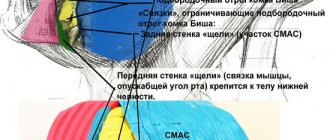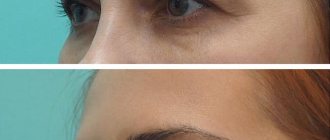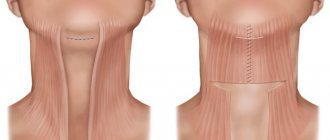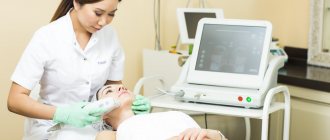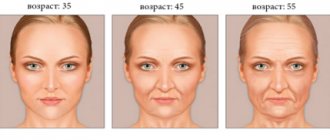Consultation with plastic surgeons with over 20 years of experience is free! Make an appointment by phone. Waiting for you! Endoscopic forehead lift (temporoplasty, brow lift) is an operation aimed at improving the aesthetic proportions of the upper third of the face. This operation belongs to the category of “beautifying” and today has become in demand and more popular than ever. The technique consists of moving and fixing the soft tissues of the forehead and eyebrow line in a higher position through mini-accesses in the scalp.
Indications for endoscopic forehead lift
- drooping eyebrows;
- Frown;
- Pronounced forehead wrinkles;
- Skin laxity;
- Decreased muscle tone - all this is an indication for a forehead lift.
The ideal age for endoscopic forehead lifting is from 30 to 45 years. However, younger patients often resort to forehead lifting. In many ways, this is due to the existing hereditary “heavy”, drooping eyebrows. Also, men and women turn to surgery when the medial edge of the eyebrow is too low.
Goals of forehead lift (temproplasty):
- Lift the outer part of the eyebrow (brow lift) and, accordingly, the tissue of the upper eyelids,
- Smooth out forehead wrinkles.
The main advantages and main advantages of the endoscopic forehead lift technique
- Long-term result of the operation,
- Natural result, no “tight mask” effect,
- Possibility of combining with other operations,
- Minimally invasive surgery
- There are no large incisions, the operation is performed through incisions no larger than 3mm,
- The use of video assistance during surgery, which avoids unnecessary tissue trauma,
- Fast rehabilitation period,
- Minimal risk of complications.
Photos before and after
Indications
At a young age, a low eyebrow, due to good tissue turgor, does not make the facial expression “heavy” or frowning. But with the advent of age-related changes, this placement of the eyebrow can significantly worsen the appearance. Therefore, endoscopic forehead lift is most often performed on women or men between the ages of 35 and 55 in order to reduce the signs of aging. However, there are a number of certain factors when it is recommended to resort to this procedure, despite age:
- noticeable horizontal forehead wrinkles;
- wrinkles on the bridge of the nose;
- excessively drooping eyebrows (or one eyebrow) both due to age-related changes and due to damage to the facial nerve;
- excess tissue of the upper eyelid;
- aesthetic unattractiveness of eyebrows (external corners are strongly lowered, low eyebrows);
- excess skin on the forehead;
- "crow's feet" at the outer corners of the eyes.
Who is this procedure contraindicated for?
- persons under 18 years of age;
- patients suffering from cancer;
- patients who experience inflammatory processes in the tissues involved in the operation;
- people who have impaired blood clotting, as well as those who take medications that reduce it;
- patients with diabetes mellitus, as well as various infectious diseases.
Before you decide to have surgery, you will need to meet with the surgeon (if necessary, there may be several such conversations). Discuss with your doctor all possible options for carrying out the procedure, study in detail the theoretical material that the specialist will recommend to you. Talk to people who have already had positive experiences with similar plastic interventions. Complete all necessary examinations and arrange for a simulation.
Advantages of the method
An endoscopic forehead lift is considered a full-fledged surgical operation, but unlike the classic lift method, it has many advantages:
- No visible marks.
- Reduced trauma.
- Modern equipment that displays an image of the internal area of the operation on a monitor allows you to carry out any manipulations with maximum precision, preserving the integrity of blood vessels and nerve endings.
- Low risk of complications.
- Accelerated rehabilitation.
- Good and long-term results.
How to determine whether this operation is suitable for your case? Where to begin?
It's simple. Consult a good plastic surgeon.
Ask a Question
Postoperative period. What should the patient prepare for?
Like any complex operation, forehead plastic surgery (see photo) has a number of not very pleasant consequences. They are not so much painful as aesthetically unattractive:
- a slight heaviness appears in the eye area. This occurs because the frontal tissues swell;
- during the first three to four months the patient experiences decreased sensitivity, but over time it returns to normal;
- discomfort, pain for a number of days after the operation.
Any disruption of natural processes in the body, and especially such a procedure, cannot pass without leaving a trace. It will take time and effort to recover. You need to be prepared in advance for the fact that your lifestyle will change noticeably and you may even have to not go to work during the first postoperative month.
Strictly follow all the recommendations of your attending physician and come to the clinic as often as possible to undergo examinations and receive advice.
Prices
| Code | Procedure name | Cost, rub. |
| F35.06.04.0.005 | Subperiosteal forehead lift (open approach) | 77000 |
| F35.06.04.0.013 | Subperiosteal endoscopic forehead lift | 77000 |
| F35.06.04.0.017 | Endoscopic periorbitoplasty | 126500 |
| F35.06.04.0.001 | Lifting the middle third of the face using a subciliary approach (check-lift) (difficulty category 1) | 85000 |
| F35.06.04.0.002 | Lifting the middle third of the face using a subciliary approach (check-lift) (difficulty category 2) | 105000 |
| F35.06.04.0.003 | Endoscopic lifting of soft tissues of the midface using subciliary access | 115000 |
| F35.06.04.0.015 | Subperiosteal endoscopic lift of the upper two-thirds of the face | 181500 |
| F35.06.04.0.016 | Subperiosteal endoscopic midface lift | 115500 |
| F35.06.04.0.006 | Cheek fat pad resection | 29500 |
| F35.06.04.0.007 | Lifting the upper two thirds of the face with SMAS plastic surgery | 140000 |
| F35.06.04.0.014 | Skin lift of the face and neck (rhetidectomy) | 165000 |
| F35.06.04.0.008 | Face and neck lift with SMAS plastic surgery | 187000 |
| F35.06.04.0.009 | Lifting the lower two-thirds of the face and neck with SMAS plastic surgery | 170000 |
| F35.06.04.0.010 | Secondary facelift | 207500 |
| F35.06.04.0.011 | Secondary face and neck lift | 283000 |
Smile to your young self!
... As we often hear: “In my heart I’m still 20...”. And sooner or later we ourselves begin to feel this unfair difference between the “imprint of years on the forehead” and spiritual impulses: we want, as in our youth, to fall madly in love, drive us crazy, stop our gazes. However, time is inexorable. That’s why we won’t beg for his favor, but simply trust an experienced specialist.
A short operation, a short recovery period - and one morning a young woman will smile at you in the mirror: her eyebrows are coquettishly arched, her eyes are laughing, and on her smooth marble forehead - not a single sad thought, not a single “line” about the past
How is the operation performed?
An endoscopic forehead and brow lift is often called an incision-free procedure. But in fact, surgery is performed through small incisions a few millimeters long in the scalp, which leave virtually no marks.
The operation is performed under general anesthesia. The duration of the operation is from 20 to 120 minutes. Through incisions under the skin, special instruments for endoscopic operations and a tube with a camera are inserted, transmitting the image to the monitor. Visual control allows the plastic surgeon to carefully exfoliate soft tissue, highlight blood vessels and nerves without damaging them. The periosteum and ligaments are dissected along the superciliary arches with special instruments, the skin on the forehead is separated from the bone and shifted back - this raises the eyebrows during the operation. Next, the skin is “fixed” in a certain position. For this, various devices are used: screws, biological glue, threads.
Endotine Forehead tissue fixation device - a new solution for effective brow lifting
The ENDOTINE Forehead Tissue Support Device is a revolutionary new solution specifically designed to lift and hold the soft tissue of the forehead during brow lift surgery. Thanks to the unique structure of the device, the teeth located on the main platform contact the soft tissues of the forehead at several points, which makes it possible to evenly and accurately distribute the tension force over the entire area of the platform. Typically, other fixation methods, such as screws and sutures, use only one point of contact at which the soft tissue is stretched or torn, and the results of the lift may disappear.
Forehead tissue fixation device :
- There is no need to install screws that protrude through the scalp, injure the postoperative scar and lead to hair loss.
- No stitches are required, which injure the hair follicles, which also leads to hair loss.
- The ENDOTINE Forehead device does not need to be removed as it is completely absorbed by the body over time.
The design of the ENDOTINE Forehead Tissue Fixation Device is specifically designed to evenly distribute tissue tension and reduce the area of stress. Thanks to this, the surgeon can achieve greater control over the aesthetic result - the height and shape of the eyebrows.
An experienced surgeon will install the ENDOTINE device in less than a minute using a few simple steps. After the eyebrows are raised to the desired height during endoscopic surgery, ENDOTINE is placed under the soft tissue of the head and provides a secure fixation. At the end of the operation, the edges of the incisions are closed with sutures, and the ENDOTINE device remains under the scalp, where it gradually dissolves.
The ENDOTINE Forehead is only a few millimeters in size. The device is made of bioabsorbable material.
«The main difficulty we encountered with endoscopic eyebrow lifting is the difficulty of fixation... In our opinion, reliable fixation is a guarantee of a predictable result of endoscopic eyebrow lifting, which depends on both the height of the eyebrows and their shape.”
Plastic and Reconstructive Surgery, Drs. Stuzin, Baker and Baker 107 (3): 872, 2001.
During surgery, the surgeon can adjust the position of the ENDOTINE Forehead device as needed to achieve the desired forehead height and shape. Thanks to this, greater control is achieved over the aesthetic result of the operation - the height and shape of the eyebrows.
Be sure to consult with your surgeon about the possibility of using the ENDOTINE Forehead device during your upcoming endoscopic brow lift.
Your questions
Is it possible to enlarge the forehead with this operation? Yes, this is possible. The operation helps to shift the hairline backwards, so the forehead becomes visually larger.
Is it possible to correct the consequences of unsuccessful Botox with this operation? Yes, this is possible. I'll tell you one of the cases in my practice. After 60 units of Botox, which were injected into the patient’s forehead in some beauty salon, the forehead muscles relaxed completely and the eyebrows dropped almost to the eyes. Endoscopy of the forehead and blepharoplasty of the lower eyelids made it possible to “raise” the forehead and get rid of drooping eyelids and bags under the eyes.
Will deep longitudinal wrinkles completely disappear? After the operation, the skin on the forehead will smooth out and tighten, but deep wrinkles will not disappear without a trace. It will be possible to get rid of longitudinal wrinkles by performing skin resurfacing in addition to tightening or, for example, filling wrinkles with filler.
Are there any contraindications to the procedure? Just like any surgical operation, endoscopic forehead lifting has some contraindications: the presence of high blood pressure; serious diseases of the gastrointestinal tract and other internal organs; cardiovascular diseases; enlargement of the thyroid gland; infectious or oncological diseases; poor blood clotting; the presence of large skin injuries in the upper area of the face. Also, the procedure is not recommended for people whose skin has completely lost its elasticity.
Preparation
After consultation to determine the price of frontal surgery of the forehead or brow ridges, preoperative preparation is necessary. In addition to all tests, consultations with a therapist, ENT doctor and anesthesiologist, it is necessary to perform radiographs in lateral and direct projections. They help the surgeon evaluate the shape of the sinuses, their true size, the thickness of the bony septa and the location of the anatomical structures.
The peculiarities of frontoplasty are that the doctor has clear anatomical points, works in the intervention area without affecting the circulatory areas and nerves, which helps to recover faster. Access along the area of hair growth helps to hide the future scar, and detachments of deep layers of tissue mask swelling and possible hematomas.

